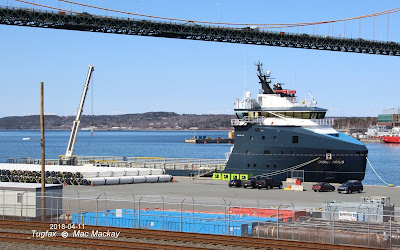In 2017 Océan took over management of the tug Pointe-Comeau, owned by Cargill Ltd. Svitzer Canada, as successors to Eastern Canada Towing (ECTUG), MIL Tug and Foundation Maritime had been the tug operators in Baie-Comeau since the port was developed in the 1950s.(The Foundation Company built the piers and were involved in several of the plants that the port serves.)
Pointe-Comeau delivered to Halifax from the shipyard.
Pointe-Comeau in Svitzer colours at Baie-Comeau.
Océan Cartier in Quebec last summer after refitting.
Océan-Cartier was built as Hai Gang 107 in 2007 by Sam Lin Shipyard for the Port of Shanghai. It is a 56 tonne bollard pull, 5,149 bhp V-S tug and therefore can provide the power needed for the larger ships now using the port. In May 2014 the tug, and two others of its class, were acquired by Svitzer, originally for use in Newcastle, NSW, Australia and was renamed Svitzer Wombi. However by December of that year it was in Singapore to be ice strengthened. Then Svitzer Wombi was re-assigned to Svitzer Canada and arrived in Halifax March 30, 2015. (It had been transported across the Pacific by heavy lift ship, but sailed on its own hull from Panama.)
As Svitzer Wombi arriving in Halifax for the first time.
Pointe-Comeau, (which will also likely to be renamed) will be transferred to Sorel-Tracy, but it would not surprise me if it eventually went to Ontario where older V-S tugs are very useful. They do not have to deal with very large ships, their agility is needed in tight quarters, and working in fresh water will extend their lives almost indefinitely.
In other Océan news, the former Océan Hercule put in to Halifax Sunday, April 29. Sold last year to West Indies Petroleum Ltd and flying the Jamaican flag as Hercule, the veteran tug spent the winter in its old home port of Sorel-Tracy before heading south.
Built in 1976 by A.M.Liaaen in Aalesund, Norway as Stril Pilot the 4400 bhp tug carried the names Spirit Sky from 1981, Ierland from 1985, Ierlandia from 1989 until acquired in 1995 by Remorquage et Sauvetage McAllister of Montreal. Renamed Charles-Antoine it was taken up by Océan in 1997 when they acquired the McAllister assets and renamed it Océan Hercule. An ice strengthened tug with 63 tonne bollard pull it has twin screws in nozzles and is powered by two turbocharged V-12 Alcos downrated to 4400 bhp and a 200 bhp bow thruster.
On the slip at Industrie Océan, Ile-aux-Coudres, Océan Hercule shows off its finely moulded deep hull and twin controllable pitch screws.
A tired looking Hercule slowly made its way into Halifax this afternoon.
The tug's hastily painted-over former name has already been partly washed away.
The crew was able to minimize the amount of new paint used to modify its previous port of registry from Montreal to Montego Bay. Note the heavy reinforcing on the stern for anchor handling.
Charles-Antoine, as it was then, arrived in Halifax for the first time July 25, 1995 on one engine. After repairs it sailed again July 26, towing the barge Marmac 15 with lifting frames to raise the barge Irving Whale. (The lift operation was cancelled that year and the Irving Whale was raised in 1996 - it is currently tied up in Halifax as Atlantic Sea Lion.)
Update:
After a couple of days in port taking stores (including lube oil I suspect) and making some unseen adjustments, Hercule sailed May 3 giving Freeport, Bahamas as the next port of call.
.






























